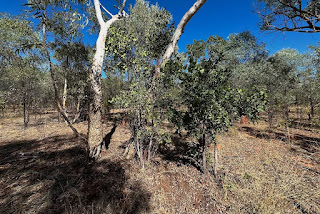[Most Recent Entries] [Calendar View]
Saturday, March 29th, 2025
| Time | Event | ||
| 5:02a | [Botany • 2025] Aulonemia insolita (Bambusoideae: Bambuseae: Arthrostylidiinae) • A New remarkable Woody Bamboo Species with internode dimorphism endemic to Bolivia and Peru
Abstract Species belonging to the genus Aulonemia have distribution across Mexico, Central America, northern and central Andes, the Guiana shield and southern Brazil. Three Aulonemia species: Aulonemia hirtula, A. queko, and A. herzogiana are known to have dimorphic internodes. In this study, we describe a new species of Aulonemia, characterized by culms with a pattern of one long internode followed by four to five shorter internodes. Notably, this species exhibits erect culm leaf blades, an uncommon trait within the genus. This study provides a comprehensive description of this new Aulonemia species, along with a distribution map, photographs and a morphological key to the species of Aulonemia with dimorphic internodes. Central Andes, dimorphic internodes, erect culm leaf blades, reflexed culm leaf blades, Monocots Ivan JIMÉNEZ-PÉREZ, Natalia REÁTEGUI, Celia Fiorella MALPARTIDA-GARAY and Eduardo RUIZ-SANCHEZ. 2025. Aulonemia insolita (Bambusoideae: Bambuseae: Arthrostylidiinae) A New remarkable Woody Bamboo Species with internode dimorphism endemic to Bolivia and Peru. Phytotaxa. 694(3); 223-234. DOI: doi.org/10.11646/phytotaxa.694.3.2 [2025-03-24] | ||
| 5:19a | [Paleontology • 2025] Garudapterus buffetauti • First gnathosaurine (Pterosauria: Ctenochasmatidae) from the Early Cretaceous of eastern Thailand Abstract Pterosaur fossils in the Mesozoic formation of Southeast Asia are very scarce. A few articles reported isolated teeth and a handful of postcranial elements in northeastern Thailand. Here we report on a pterosaur upper jaw from the Early Cretaceous at Phra Prong locality of eastern Thailand, which is considered the lateral equivalent of the Sao Khua Formation of the Khorat Group. This represents the first pterosaur cranial material in Thailand. It comprises a partial rostrum, preserving eleven tooth positions, and four associated tooth crowns. The anterior tip of the rostrum is dorsoventrally flattened and laterally expanded (spoon-shaped), indicating affinities to the Gnathosaurinae (Ctenochasmatidae). Alveoli borders are conspicuously scalloped and collar-like, and the palatal surface exhibits a pair of sinusoidal grooves. These features bear a strong resemblance to the Late Jurassic gnathosaurines Gnathosaurus subulatus, Tacuadactylus luciae, and Lusognathus almadrava. Our phylogenetic analysis indicates that the Thai pterosaur is closely related to these gnathosaurines. Still, the Thai gnathosaurine is unique in exhibiting a kite-shaped rostrum expansion and is recognized as a new taxon herein named Garudapterus buffetauti gen. et sp. nov. This new specimen provides essential information regarding pterosaurs, including updated data for a better understanding of their diversity and distribution throughout Southeast Asia. Systematic Palaeontology Pterosauria Owen, 1842 Pterodactyloidea Plieninger, 1901 Ctenochasmatoidea Unwin, 1995 Ctenochasmatidae Nopcsa, 1928 Gnathosaurinae Nopcsa, 1928 Garudapterus gen. nov. Garudapterus buffetauti gen. et sp. nov. Conclusions: The new specimen, which represents the first pterosaur skull material ever recovered from Southeast Asia, exhibits several anatomical features that allow for a confident assignment to the Gnathosaurinae (Pterodactyloidea, Ctenochasmatoidea), most importantly a spatulate rostrum containing a large number of lateralized alveoli. Being quite distinguishable from other members of this group, the new specimen is herein recognized as a new genus and species, named Garudapterus buffetauti gen. et sp. ... Sita Manitkoon, Rodrigo V. Pêgas, Thanit Nonsrirach, Prapasiri Warapeang, Komsorn Lauprasert, Uthumporn Deesri, Sakboworn Tumpeesuwan, Kamonlak Wongko and Xuanyu Zhou. 2025. First gnathosaurine (Pterosauria, Pterodactyloidea) from the Early Cretaceous of eastern Thailand. Cretaceous Research. In Press, 106135. DOI: 10.1016/j.cretres.2025.106135 facebook.com/DinoThaiThai/videos/642396331745015 | ||
| 3:08p | [Herpetology • 2025] Lerista karichigara • A New fossorial Skink (Scincidae: Sphenomorphini) from Australia's underexplored Gulf Plains Bioregion
Abstract We describe a new species of fossorial skink, Lerista karichigara sp. nov., from the Gulf Plains Bioregion of northern Queensland, Australia. The new species lacks forelimbs, has hindlimbs with two toes, and is characterised by a colour-pattern of fine, dark longitudinal lines. Although field guides and keys available at the time of publication would identify this species as L. wilkinsi, it differs from that allopatric species in several respects. Notably, L. karichigara sp. nov. has only two supraciliaries that do not contact each other (versus four, with the first three in a continuous row), and a snout shape that is sharper in profile. Mitochondrial DNA sequence data indicate L. karichigara sp. nov. is deeply divergent from other known Lerista species and is possibly sister to a clade of nine species from north-eastern Australia, referred to here as the L. wilkinsi clade. Lerista karichigara sp. nov. appears to be the first vertebrate recognised as endemic to the Gulf Plains Bioregion, an expansive and poorly surveyed region of tropical northern Australia. We also report new geographic records for L. vanderduysi and L. emmotti, which extend their known distributions. Reptilia, Queensland, Lerista wilkinsi, Lerista vanderduysi, Lerista emmotti, Tagalaka Slider, savanna Stephen M. ZOZAYA, Eric VANDERDUYS, Scott A. MACOR, Wesley J. READ and Andrew P. AMEY. 2025. Lerista karichigara sp. nov. (Scincidae; Sphenomorphini), A New fossorial Skink from Australia's underexplored Gulf Plains Bioregion. Zootaxa. 5613(2); 262-278. DOI: doi.org/10.11646/zootaxa.5613.2.3 [2025-03-27] |
| << Previous Day |
2025/03/29 [Calendar] |
Next Day >> |













